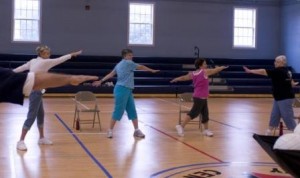Exercise Better than Mental or Social Activity to Protect Brain from Shrinkage, Study Finds

A new study published in Neurology, the medical journal of the American Association of Neurology, has found that among older adults, regular exercise was more effective in protecting against brain shrinkage than were either mental or social activities.
Some brain shrinkage normally accompanies aging, but research has found that more severe brain shrinkage or atrophy is associated with memory problems and cognitive decline, according to a news release issued by the American Association of Neurology.
The new study, conducted by Alan J. Gow, PhD, of the University of Edinburgh, Scotland, and colleagues, was published in the October 23, 2012 issue of Neurology®, the medical journal of the American Academy of Neurology.
The Study; Methodology
The researchers examined medical records of 638 people in Scotland who were born in 1936.
At Age 70 the participants answered questions about their physical and leisure activities. Among the information gathered were self-reported details about the participants’ exercise habits, including extent of participation in fitness exercise or competitive sports as well as movement in connection with household chores and every day activities. The participants also reported details about their engagement in mentally stimulating activities and social activities.
At Age 73, the participants underwent MRI scans to measure for various markers of brain volume or brain atrophy. Scientifically, the authors explained their examination procedures as follows:
Scientific literature indicates that “fractional anisotropy (FA)” is a widely used measure of the integrity of white matter in the brain, which is thought to be an indicator of brain integrity or brain shrinkage or atrophy.
“White matter lesions (WML)” is a term that refers to small areas of dead cells found in parts of the brain consisting of white matter that act as connectors. Studies indicate that while white matter lesions are commonly found in MRI scans of older person’s brains, and may to some extent occur normally with aging, nevertheless, the extensive presence of “White matter lesions tended to be associated with lower scores on tests of cognitive function and were significantly associated with subjective mental decline.”
Findings
The new study found that after three years, people who participated in more physical activity experienced less brain shrinkage or atrophy, as measured by the indicators mentioned above, than those who exercised minimally.
“A higher level of physical activity was associated with higher FA, larger gray and NAWM volumes, less atrophy, and lower WML load,” the authors wrote.
“The physical activity associations with atrophy, gray matter, and WML remained significant after adjustment for covariates, including age, social class, and health status,” they found.
However, they also found that “Leisure activity [other than exercise — such as mental or social acticvities] was associated with NAWM volume, but was nonsignificant after including covariates.”
“People in their seventies who participated in more physical exercise, including walking several times a week, had less brain shrinkage and other signs of aging in the brain than those who were less physically active,” the study author, Alan J. Gow, PhD., said in a news release issued by the American Academy of Neurology.
“On the other hand, our study showed no real benefit to participating in mentally and socially stimulating activities on brain size, as seen on MRI scans, over the three-year time frame,” said Dr. Gow.
Conclusions; Implications
In conclusion, the authors wrote, “In this large, narrow-age sample of adults in their 70s, physical activity was associated with less atrophy and WML [white matter lesions]. Its role as a potential neuroprotective factor is supported; however, the direction of causation is unclear from this observational study.”
“Our results show that regularly exercising in old age is potentially important to protecting the brain as we age,” concluded Dr. Gow, the study author.
More Information
The complete report of the new study is available online in the October 23, 2012 issue of Neurology®, the medical journal of the American Academy of Neurology.
See related HelpingYouCare® reports on:
Decline in Physical Abilities Linked to Increased Risk for Dementia Among 90 Year Olds, Study Finds
Omega-3 in Fish & Other Foods May Keep Your Brain Sharper, New Study Finds
Fruits, Vegetables & Fish May Keep Brain from Shrinking, New Study Finds
Strength Training & Walking Improve Brain & Memory, New Studies Find
Weight Loss and Walking Exercise Improve Memory, Studies Find
Physical Inactivity May Cause as Many Deaths as Smoking, New Study Calculates
Experts Advocate Dancing for Health
For more information on dementia/ Alzheimer’s Disease and memory problems, see the HelpingYouCare®resource pages on Alzheimer’s/ Dementia, including:
- Latest News;
- What is it; Causes;
- Symptoms & Diagnosis;
- Prevention;
- Treatment (there currently is no cure); and
- Caregiving
For further information on dementia, see the website of the American Academy of Neurology. According to their news release, “The American Academy of Neurology, an association of more than 25,000 neurologists and neuroscience professionals, is dedicated to promoting the highest quality patient-centered neurologic care. A neurologist is a doctor with specialized training in diagnosing, treating and managing disorders of the brain and nervous system such as Alzheimer’s disease, stroke, migraine, multiple sclerosis, brain injury, Parkinson’s disease and epilepsy.”
_____________
Copyright © 2012 Care-Help LLC, publisher of HelpingYouCare®. All rights reserved. Posted with permission from HelpingYouCare.com.

